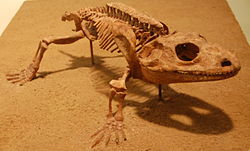Cacops morrisi
|
Cacops Temporal range: Early Permian, Kungurian |
|
|---|---|
 |
|
| Skeleton of Cacops aspidephorus in the Field Museum | |
| Scientific classification | |
| Kingdom: | Animalia |
| Phylum: | Chordata |
| Order: | †Temnospondyli |
| Family: | †Dissorophidae |
| Clade: | †Eucacopinae |
| Genus: |
†Cacops Williston, 1910 |
| Species | |
Cacops (Greek for "blind face"), a genus of dissorophid temnospondyls, is one of the most distinctive Paleozoic amphibians that diversified in the equatorial region of Pangea during the Kungurian stage of the Early Permian. Dissorophids were a group of fully terrestrial, often heavily armored predators. This contrasts with the majority of aquatic or amphibious anamniotes, which not did develop into clearly defined terrestrial adults. This, along with their relatively large size and geographical range suggest that they were able to coexist with amniotes as predators before the Permo-Triassic extinction event. Dissorophidae has two distinct clades differentiated on the morphology of the osteoderms, the Eucacopinae (previously Cacopinae) and the Dissorophinae. Cacops is one of the few olsoniforms (dissorophids and the larger trematopids) whose ontogeny is beginning to surface.Cacops fossils have previously only come from the Cacops Bone Bed during the Lower Permian of Texas. However, new material collected from the Dolese Brothers Quarry, near Richards Spur, Oklahoma and the Fort Sill fissure fills has been recovered, painting a clearer picture of what the animal looked and acted like.
American paleontologist Samuel Wendell Williston used the details of the species Cacops aspidephorus to first describe its features. However, because of the poor preservation of specimens collected from the Cacops Bone Bed in Texas, other researchers who collected specimens from other localities have described many of Cacops’ features with more certainty.
The skull is very box-like and its cheeks aligned almost at a right angle to the skull table. The external cranial ornament is noticeable on the skull table and on top of the ridges that border the numerous depressions. One significant ontogenetic change in Cacops is a more evenly distributed ornamentation in the adults. Another important feature of the skull is the tip of the snout, which has a teardrop shaped internarial fontanelle, evident in both adult and juvenile specimens. Like other dissorophids, the temporal region of Cacops’ skull was dominated by the tympanic embayment, which likely housed a large tympanum. Marginal teeth are recurved and thinner than in other temnospondyls. The palatal dentition consists both of recurved tusks larger than the marginal teeth and strong recurved teeth that cover most of the palatal surface.
...
Wikipedia
